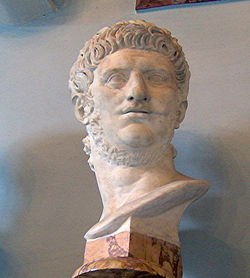Nero: Difference between revisions
imported>Richard Nevell (A bit on history's judgement of Nero) |
imported>Richard Nevell (Add photo) |
||
| Line 1: | Line 1: | ||
{{subpages}} | {{subpages}} | ||
{{Image|Nero bust.jpg|thumb|250px|right|A bust of the Emperor Nero}} | |||
'''Nero Claudius Caesar Augustus Germanicus''', commonly referred to as '''Nero''', was [[Roman Emperor]] from A.D. 54 to his death in A.D. 68. He succeeded the Emperor [[Claudius]], who had adopted him in A.D. 50; Claudius already had a son, Britannicus.<ref>Le Glay, Marcel; Voisin, Jean-Louis; Le Bohec, Yann; Cherry, David & Kyle, Donald (2006). ''A History of Rome'', 3rd edition. pp. 234–235. Blackwell Publishing. ISBN 1-4051-1083-X</ref> | '''Nero Claudius Caesar Augustus Germanicus''', commonly referred to as '''Nero''', was [[Roman Emperor]] from A.D. 54 to his death in A.D. 68. He succeeded the Emperor [[Claudius]], who had adopted him in A.D. 50; Claudius already had a son, Britannicus.<ref>Le Glay, Marcel; Voisin, Jean-Louis; Le Bohec, Yann; Cherry, David & Kyle, Donald (2006). ''A History of Rome'', 3rd edition. pp. 234–235. Blackwell Publishing. ISBN 1-4051-1083-X</ref> | ||
Revision as of 16:11, 12 December 2012
Nero Claudius Caesar Augustus Germanicus, commonly referred to as Nero, was Roman Emperor from A.D. 54 to his death in A.D. 68. He succeeded the Emperor Claudius, who had adopted him in A.D. 50; Claudius already had a son, Britannicus.[1]
Nero was born Lucius Domitius Ahenobarbus in A.D. 37, during the reign of Caligula; he was the son of Julia Agrippina and Gnaeus Domitius Ahenobarbus. Julia's father, Germanicus Caesar, had been adopted by the Emperor Tiberius and the people of Rome felt that the family were the heirs of Augustus, who had himself adopted Tiberius. Gnaeus Domitius Ahenobarbus died in A.D. 39. Agrippina was exiled the same year, and took her son with her, but the ascension of Claudius in A.D. 41 saw them recalled to Rome.[2] Nero was just 17 when Claudius died, and when the Praetorian Guard proclaimed him emperor he was the youngest man to have held the position.[3]
The surviving literature from the Roman world is united in the opinion that Nero was a tyrant. For instance Pliny the Elder wrote that Nero was "the destroyer of the human race". In later historiography he was considered the archetypal despot along with figures such as Caligula. In Christian writings Nero was considered the Anti-Christ, an opinion which gained popularity as Christianity became a mainstream religion.[4]
- ↑ Le Glay, Marcel; Voisin, Jean-Louis; Le Bohec, Yann; Cherry, David & Kyle, Donald (2006). A History of Rome, 3rd edition. pp. 234–235. Blackwell Publishing. ISBN 1-4051-1083-X
- ↑ Shotter, David (2005). Nero, 2nd edition. London: Routledge. pp. 10–11. ISBN 0-415-31941-2.
- ↑ Le Glay et al, A History of Rome, p. 235.
- ↑ Griffin, Miriam T. (1987). Nero: The End of a Dynasty. London: Routledge. p. 15. ISBN 978-0415214643.
